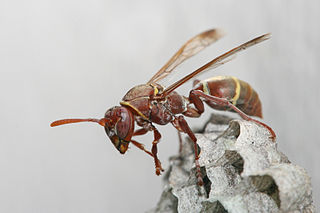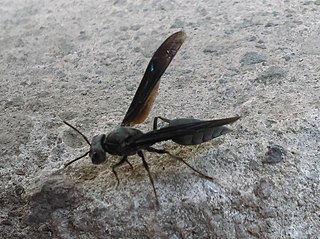
The Polistinae is a subfamily of eusocial wasps belonging to the family Vespidae. They are closely related to the more familiar wasps and true hornets of the subfamily Vespinae, containing four tribes. With about 1,100 species total, it is the second-most diverse subfamily within the Vespidae, and while most species are tropical or subtropical, they include some of the most frequently encountered large wasps in temperate regions.

Polistes annularis is a species of paper wasp found throughout the eastern half of the United States. This species of red paper wasp is known for its large size and its red-and-black coloration and is variably referred to as a ringed paper wasp or jack Spaniard wasp. It builds its nest under overhangs near bodies of water that minimize the amount of sunlight penetration. It clusters its nests together in large aggregations, and consumes nectar and other insects. Its principal predator is the ant, although birds are also known to prey on it. Unlike other wasps, P. annularis is relatively robust in winter conditions, and has also been observed to store honey in advance of hibernation. This species has also been used as a model species to demonstrate the ability to use microsatellite markers in maternity assignment of social insects.

Polistes fuscatus, whose common name is the dark or northern paper wasp, is widely found throughout southern Canada, the United States, Mexico, and Central America. It often nests around human development. However, it greatly prefers areas in which wood is readily available for use as nest material, therefore they are also found near and in woodlands and savannas. P. fuscatus is a social wasp that is part of a complex society based around a single dominant queen along with other cofoundresses and a dominance hierarchy.

Polistes exclamans, the Guinea paper wasp, is a social wasp and is part of the family Vespidae of the order Hymenoptera. It is found throughout the United States, Mexico, the Bahamas, Jamaica and parts of Canada. Due to solitary nest founding by queens, P. exclamans has extended its range in the past few decades and now covers the eastern half of the United States, as well as part of the north. This expansion is typically attributed to changing global climate and temperatures. P. exclamans has three specific castes, including males, workers, and queens, but the dominance hierarchy is further distinguished by age. The older the wasp is, the higher it is in ranking within the colony. In most P. exclamans nests, there is one queen who lays all the eggs in the colony. The physiological similarities between the worker and queen castes have led to experiments attempting to distinguish the characteristics of these two castes and how they are determined, though males have easily identifiable physiological characteristics. Since P. exclamans live in relatively small, open combed nests, they are often subject to predators and parasites, such as Chalcoela iphitalis, Elasmus polistis, and birds. P. exclamans have defense and recognition strategies that help protect against these predators and parasites.

Polybia occidentalis, commonly known as camoati, is a swarm-founding advanced eusocial wasp. Swarm-founding means that a swarm of these wasps find a nesting site and build the nest together. This species can be found in Central and South America. P. occidentalis preys on nectar, insects, and carbohydrate sources, while birds and ants prey on and parasitize them. P. occidentalis workers bite each other to communicate the time to start working.

Polistes bellicosus is a social paper wasp from the order Hymenoptera typically found within Texas, namely the Houston area. Like other paper wasps, Polistes bellicosus build nests by manipulating exposed fibers into paper to create cells. P. bellicosus often rebuild their nests at least once per colony season due to predation.

Protonectarina sylveirae, commonly referred to as the Brazilian wasp, is a neotropical swarm-founding wasp species that ranges widely across South America. This species relies heavily on the consumption of animal protein rather than nectar. P. sylveirae preys heavily on agricultural pests to coffee crops, keeping pest populations low.

Ropalidia revolutionalis Ropalidia revolutionalis, the small brown paper wasp, is a diurnal social wasp of the family Vespidae. They are known for the distinctive combs they make for their nests, and they are mostly found in Queensland, Australia in the areas of Brisbane and Townsville. They are an independent founding wasp species, and they build new nests each spring. They can be helpful because they control insect pests in gardens. However, if threatened, they will sting humans and cause large amounts of pain.

Leipomeles dorsata is a neotropical paper wasp that is found across Central America and northern South America. It is a eusocial wasp with little differentiation between reproducing and non-reproducing females. In fact, workers can become temporary reproductives if the main reproductives are killed, allowing reproduction to continue until the main reproductive population recovers. The colony cycles through different ratios of main reproductive females and subordinate reproductive females, starting with few or no primary reproducing females, and increasing until there are only main reproductives.
Protopolybia exigua is a species of vespid wasp found in South America and Southern Brazil. These neotropical wasps, of the tribe Epiponini, form large colonies with multiple queens per colony. P. exigua are small wasps that find nourishment from nectar and prey on arthropods. Their nests are disc-shaped and hang from the undersides of leaves and tree branches. This particular species of wasp can be hard to study because they frequently abandon their nests. P. exigua continuously seek refuge from phorid fly attacks and thus often flee infested nests to build new ones. The wasps' most common predators are ants and the parasitoid phorid flies from the Phoridae family.

Polybia sericea is a social, tropical wasp of the family Vespidae that can be found in South America. It founds its colonies by swarming migrations, and feeds on nectar and arthropods.
Polybioides raphigastra is a species of social wasp found in the forests of South East Asia and Indonesia. It has recently been placed in the tribe Ropalidiini. This species is known for the downward-spiraling shape of their nests, and for having colony sizes exceeding ten thousand members.
Polybia emaciata is a Neotropical swarm founding wasp that is mainly found in South America. This eusocial species has a unique colony structure in which multiple queens are present. Workers and queens are not morphologically distinct, but the high amount of relatedness maintained in the colony ensures that workers police each other. Polybia emaciata relies on a diet of liquid nectars which is supplemented with prey insects, particularly flies. It is well known for being one of only three wasp species in the genus Polybia that uses mud as the primary material for building its nest. Polybia emaciata is one of the least aggressive wasp species in the genus Polybia, and is known for its distinctive defensive behavior.

Ropalidia romandi, also known as the yellow brown paper wasp or the yellow paper wasp. is a species of paper wasp found in Northern and Eastern Australia. R. romandi is a swarm-founding wasp, and manages perennial nests. Its nests are known as 'paper bag nests' and have different architectural structures, depending on the substrates from which they are built. The specific name honors Gustave, baron de Romand, a prominent French political figure and amateur entomologist.
Synoeca surinama is a Neotropical swarm-founding wasp of the tribe Epiponini. It is known for its metallic blue and black appearance and painful sting. S. surinama builds nests on tree trunks and can be found in tropical climates of South America. When preparing to swarm, there are a number of pre-swarming behaviors that members of S. surinama colonies partake in, such as buzzing runs and occasional brood cannibalism. In S. surinama, social environmental conditions determine the caste ranks of individuals in the developing brood. Unlike less primitive Hymenoptera species, S. surinama display little morphological variation between egg laying queens and workers. S. surinama wasps visit flowering plants and are considered pollinators. When these wasps sting, the stinger is left in the victim and the wasp ultimately dies.

Synoeca septentrionalis is one of five species of wasps in the genus Synoeca. It is a swarm-founding wasp that is also eusocial, exhibiting complicated nest structure and defense mechanisms and a colony cycle including a pre-emergence phase and a post-emergence phase. It is typically found in areas from Central to South America. This wasp is one of the larger species of paper wasps and exhibits multiple morphological adaptations as a result of this. S. septentrionalis is known for possessing a very painful sting.
Agelaia multipicta is a swarm-founding, highly eusocial wasp that lives in Mexico, Argentina, Trinidad and southern Brazil. It nests in natural cavities such as hollow trees and aggressively defends the nest from ants, who are brood predators. The workers and queens are morphologically distinguished by ovarian development as well as external features such as a larger petiole and gaster in the queen. Like other carrion-eating (necrophagous) wasp species, A. multipicta plays a scavenging role in the ecosystem. Agelaia multipicta was described by the Irish entomologist Alexander Henry Haliday in 1836.
Parachartergus colobopterus is an epiponine social wasp belonging to the subfamily Polistinae. This species can be found through Central and South America and is unique because its colonies contain multiple queens. However, relatedness among nest mates remains relatively high as a result of cyclical oligogyny, which is a system where the number of queens varies over time. Because workers and queens do not demonstrate any significant morphological differentiation, individuals of this species are totipotent, capable of differentiation into any caste, because caste is not genetically determined. Relatedness and conflict therefore play a major role in determining the dominance hierarchy and behavioral patterns of this wasp species, especially the behavior of worker policing. Another unique characteristic of this wasp is that it is generally a docile species: when the nest is continuously provoked, the colony members will leave the nest instead of mounting an attack.

Mischocyttarus mexicanus cubicola is a neotropical paper wasp found in the New World. It is a social wasp that demonstrates two different types of nesting strategies, depending upon context. This context-dependent trait makes Mischocyttarus mexicanus cubicola a good model to study social biology within social wasps. In detail, this trait allows for the females of this species to form nests both individually and as co-founders with other females within the same colony. This subspecies is also known to exhibit cannibalism, with M. m. cubicola queens feeding on their own larvae for nourishment when unaided by workers.
Polybia paulista is a species of eusocial wasp occurring in Brazil, Paraguay, and Argentina.











